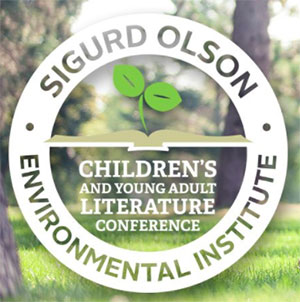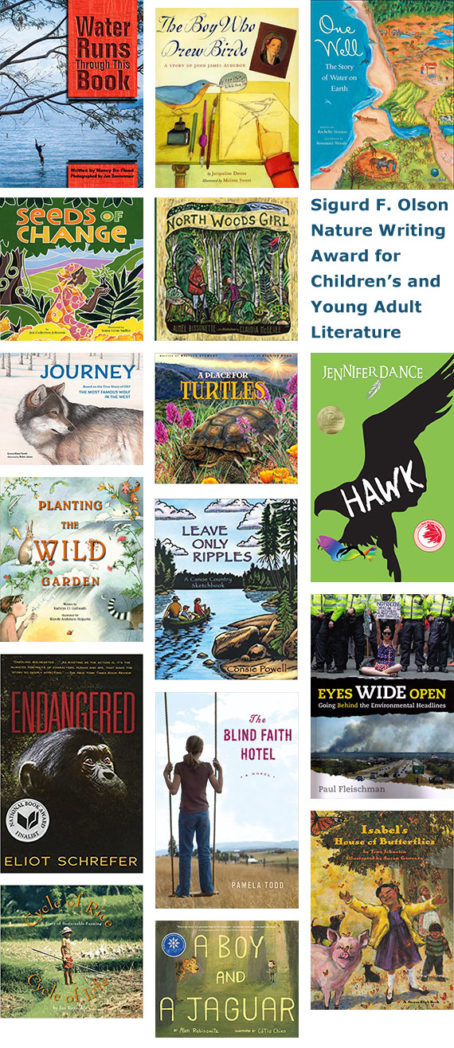 We’re in the midst of award season, when best of the year lists and speculation about award winners proliferate on the social media platforms swirling around children’s and teen books. In November, we attended the award ceremony at the Sigurd Olson Environmental Institute’s Children and Young Adult Literature Conference, which takes place at Northland College in Ashland, Wisconsin (on the awe-inspiring south shore of Lake Superior). Inspired by the authors, naturalists, and librarians who speak at this conference, we interviewed the dedicated committee who select this important award each year.
We’re in the midst of award season, when best of the year lists and speculation about award winners proliferate on the social media platforms swirling around children’s and teen books. In November, we attended the award ceremony at the Sigurd Olson Environmental Institute’s Children and Young Adult Literature Conference, which takes place at Northland College in Ashland, Wisconsin (on the awe-inspiring south shore of Lake Superior). Inspired by the authors, naturalists, and librarians who speak at this conference, we interviewed the dedicated committee who select this important award each year.
How do you select the awarded books?
We have a committee of eight members who all have an interest in promoting both the natural world and high quality literature for children. Because committee members remain on the committee from year to year we have a dedicated, knowledgeable group of professionals. Each member first ranks books and then those results are tallied. The top ranked books becomes the focus of a committee meeting. A final vote is taken with numerical rankings following that in-depth discussion.
What are the criteria for this award?
The Sigurd F. Olson Nature Writing Award for Children’s Literature is given to a published children’s book of literary nature writing (nonfiction or fiction) that captures the spirit of the human relationship with nature, and promotes the awareness, preservation, appreciation, or restoration of the natural world for future generations. (Here's a full list of SONWA books since 1991.)
How do you gather the books?
Since most, if not all, publishers are on Twitter, we established a SONWA Awards Twitter account two years ago (@sonwa_awards). For the past two years, we’ve promoted the awards through our feed and by directly tweeting to publishers. We also post to the SOEI (Sigurd Olson Environmental Institute) Facebook feed periodically.
We actively ask publishers to submit books that fit the criteria. Since we’re one of the few nature writing awards for young adult and children’s literature, the publishers of this type of book are aware of us.
What selection criteria do you apply?
First of all, as the name of the award suggests, the book has to be about some aspect of nature and written for children appropriate to the age group. In addition, it has to be written in the year prior to the year the award is received.
After that, we look at:
- Human Relationships with Natural World: Does the book capture the spirit of the human relationship with nature?
- Literary Value: Does the book take on elements such as character development, metaphor, climax, allusion, theme, motif, etc?
- Values: Does the book promote the values for nature this award seeks to promote for future generations: awareness, preservation, appreciation, restoration?
- Illustrations: When books meet all the above criteria, then illustrations and the artwork are considered.

What is the impetus you feel for donating your time to this award process?
Living in the Northwoods, whether an outdoor person or not, creates a strong connection to the earth and concern for its future. Our committee is also well aware of how literacy can impact our humanity. This award process allows us to commit to two efforts that are important to us. We hope the chain from writers to publishers will be validated for their efforts. And we hope the reader will be enriched in multiple ways.
You are housed within, and sponsored by, the Sigurd Olson Environmental Institute. Why is this a good fit for a nature-writing award?
The mission of the Sigurd Olson Environmental Institute is to promote experiences of wildness and wonder, while also working to protect wildlands for future generations. Literary depictions and accounts of wild nature and the wonder it evokes in people often inspire readers to seek similar experiences, or, if they’ve already had those experiences, the literary works help to further affirm the value of those experiences.
Sigurd F. Olson’s writing is one of the richest and most influential parts of his legacy, and the nature writing award is one of the ways that we carry that legacy forward.

Your focus was initially regionally written adult books. Why did you develop a specific award for children’s books?
In part this was a circumstantial decision: each year publishers were submitting children’s books, even though they didn’t meet the criteria we had established for the original adult award. Although we could not consider these submissions for the adult award, we were impressed by their quality and wanted to recognize and promote the work of the authors and illustrators of the children’s books.
Of course, we also recognize how important it is to capture the imaginations of children and the role that stories can play in shaping their values and visions for themselves and their future. We want children to grow up having and valuing experiences of wildness and wonder in their lives, and the children’s nature writing award, as well as our children’s literature conference, help us to realize this goal.
Having read so many nature-themed children’s books, what trends are you noticing?
We do see topic trends from time to time. A few years ago it was whales and then water the next year. Just like publishing in other areas, the trends tend to follow what is going on in the world. This year we have a few hurricane books. Often times, grandparents are depicted as nurturer, guardian, or storyteller of nature.
We are seeing more diversity and inclusion. There are more picture books with more white space but with detailed author notes or supplemental added value. In recent year, nonfiction books for older readers will have side bars, graphics, captioned photos, and more alongside the main body. This can be either an enhancement or a distraction.
What themes or topics do you wish were being addressed in children’s books?
We are always looking for books that have a strong relationship to human interaction with the natural world. Books for older children with this aspect are not as readily available. There are always some that stand out in this area but we would happily welcome more.
___________________
Thank you for your commitment to reading and recommending the very best in nature writing for children and teens. Your focus on human interaction with the natural world is critical to the lives of our children and our planet. Important work you’re doing!
[The submission deadline for 2018 award consideration is December 31, 2017. Learn more.]
